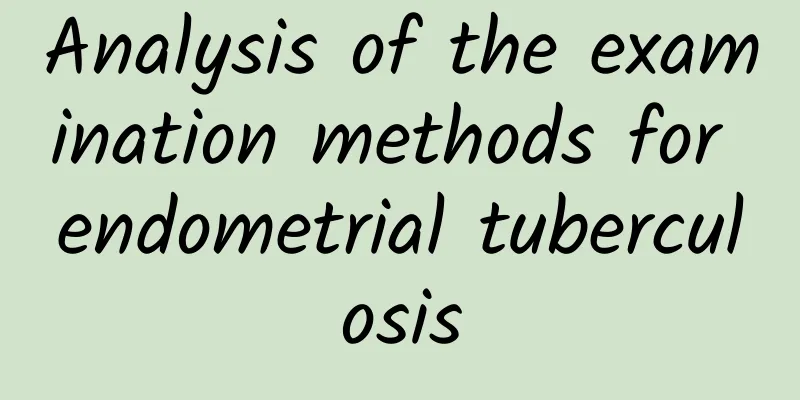Analysis of the examination methods for endometrial tuberculosis

|
The emergence of endometrial tuberculosis requires a comprehensive understanding, and attention should be paid to reasonable treatment, and some inspection methods should be paid attention to effectively improve the patient's physical fitness and avoid causing more harm. At the same time, attention should also be paid to reasonable adjustment and reasonable treatment. What are the common inspection methods for endometrial tuberculosis? X-ray examination: There is hysterosalpingography. Women have endometrial tuberculosis, tuberculosis lesions in the posterior wall of the uterus, uterosacral ligaments, rectum and appendages, etc., which leads to the posterior position of the uterus, which is fixed and forms a mushroom or parasol shape. The ovaries are cystic and enlarged, and iodized oil residues around the umbrella end. The patency of the fallopian tube is blocked. Due to adhesions in the pelvic cavity, 24-hour X-ray review shows that the iodized oil in the pelvic cavity is in the form of small lumps, of varying thickness, and distributed in a dot-like snowflake pattern. B-ultrasound examination: B-ultrasound is currently an effective method for assisting the diagnosis of endometrial tuberculosis. It is used to observe ovarian endometrial tuberculosis cysts. The characteristics of the sonogram are: cystic masses are common images, with blurred boundaries, sparse light spots inside, thick cystic fluid, and sometimes dense, coarse light spots appear due to the concentration and organization of old blood clots, which is a mixed mass; the mass is often located on the posterior side of the female uterus, and cystic uterine concomitant symptoms can be seen, that is, the cyst image and the uterine image overlap to varying degrees; the cyst sometimes ruptures spontaneously, and fluid can be seen in the posterior concave, and the internal cyst is smaller than the front. Laparoscopy: Currently, it is the main method for diagnosing endometrial tuberculosis. The pelvic cavity can be directly peeked in, and tuberculosis foci can be clearly diagnosed, and staging can be performed based on the findings, and then treatment can be performed. There are many manifestations of tuberculosis foci under laparoscopy: the color of the lesions can be red, blue, black, brown, white, gray, etc.; the shape of the lesions can be dot-like, nodular, vesicular, polyp-like, etc. Sometimes peritoneal defects or small pouches are seen, with tuberculosis foci at the bottom. Immunological testing: Studies have shown that the onset of endometrial tuberculosis is related to immunity, female cellular immunity, and endometrial fragments can be implanted in the peritoneum, leading to endometriosis. Currently, there are several immune indicators that can be used as a reference for diagnosing endometriosis: macrophages; interleukin I and II; autoantibodies; cellular immunity, humoral immunity, and complement. |
<<: How to check for endometrial tuberculosis
>>: How do I know if I have endometrial tuberculosis?
Recommend
The price of tea eggs in convenience stores has increased! Understand calories, protein, and cholesterol at once!
The price of tea eggs in convenience stores is go...
Experts briefly analyze the common symptoms of ectopic pregnancy
The symptoms of ectopic pregnancy are often sever...
Vegetables can also be easily cooked in an air fryer! 3 delicious low-sugar vegetarian dishes, ready in half an hour
The difficulty in losing weight is not in getting...
The main cause of pelvic inflammatory disease
Among women's gynecological diseases, pelvic ...
Do I need to have my uterus removed if I have cervical precancerous lesions?
Cervical precancerous lesions generally refer to ...
What are the complications caused by cervical warts?
What are the complications of cervical warts? To ...
What does pelvic effusion mean, is it a disease, and can it be cured?
Pelvic effusion is usually a physical sign, not a...
The rock bath actually smells like medicine! Ginseng replenishes Qi and adjusts physical condition
Office workers are under great work pressure, whi...
Typical symptoms of patients with atrophic vulvar leukoplakia at various stages
Atrophic vulvar leukoplakia is a common type of v...
Which hospital is better for treating pelvic peritonitis?
Pelvic peritonitis is the most painful disease fo...
How to treat pelvic effusion
How is pelvic effusion treated? Pelvic effusion i...
Lose weight and don’t gain it back! Nutritionist: Don’t fall into the trap of rapid weight loss
Obesity is the public enemy, but when it comes to...
Experts explain what adnexitis is
Adnexitis is very common in our country, and we s...
TCM's understanding of the etiology of trichomonas vaginitis
Trichomonas vaginitis is a type of vaginitis caus...
What are the symptoms of severe cervicitis?
Cervicitis is one of the common diseases among wo...









